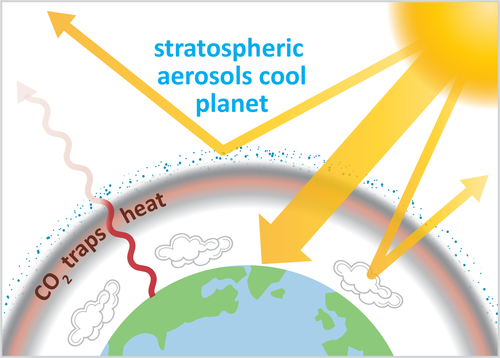 Geoengineering technologies are conventionally organized into two main categories. Albedo modification (also referred to as ‘solar radiation management’ (SRM) or ‘solar geoengineering’) methods include technologies designed to reflect a small fraction of incoming sunlight back to space in order to attenuate anthropogenic changes in temperature and other climate variables.
Geoengineering technologies are conventionally organized into two main categories. Albedo modification (also referred to as ‘solar radiation management’ (SRM) or ‘solar geoengineering’) methods include technologies designed to reflect a small fraction of incoming sunlight back to space in order to attenuate anthropogenic changes in temperature and other climate variables.
Examples of albedo modification technologies include stratospheric aerosol injection and marine cloud brightening. The former would introduce small particles into the upper atmosphere to scatter sunlight back to space; the latter would spray seawater into low-lying marine cloud formations thereby whitening clouds and increasing their albedo (reflectivity).
Carbon dioxide removal (CDR) (also known as ‘air capture’ or sometimes, confusingly, as ‘direct carbon removal’ (DCR)), by contrast, seeks to draw down and sequester carbon dioxide from the air, so as to reduce the overall concentration of CO2 in the atmosphere. CDR methods include direct air capture of carbon dioxide by chemical means using industrial-scale plants, and bio-energy with carbon capture and storage , which combines carbon capture technology with biomass as an energy source to produce “negative emissions” of CO2.
While CDR methods entail novel technologies, innovative processes, and new technical configurations, the most plausible carbon extraction techniques closely resemble existing mitigation approaches (such as afforestation, sustainable land-use management, and carbon capture and storage), and hence present few (if any) wholly original problems. In fact, in economic analyses of mitigation, bio-energy with carbon capture and storage plays a major role in most scenarios of aggressive emissions cuts.
Albedo modification technologies, on the other hand, would be relatively fast-acting (yielding results in years to decades), comparatively inexpensive (costing as little as $1 to $10 billion per year), and extremely high-leverage in their effects (a gram of aerosol in the stratosphere can offset the warming effect of a ton of carbon dioxide, representing a factor of a million to one).
Climate-modeling studies show that albedo modification is surprisingly effective, offsetting many but not all climate risks associated with global warming. Indeed, the results of these studies, combined with observations of the effects of natural perturbations of the atmosphere such as volcanic eruptions, suggest there is little doubt that albedo modification could limit global mean temperature rise to 2°C. These attributes make albedo modification a potentially hugely disruptive technology on a truly global scale.
Because of these large differences between albedo modification and carbon dioxide removal methods, the Keith Group focuses only on albedo modification.
